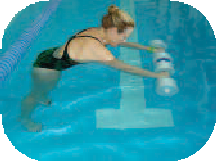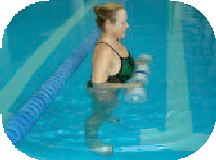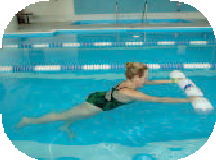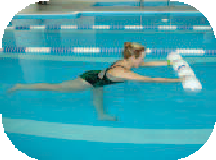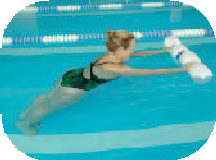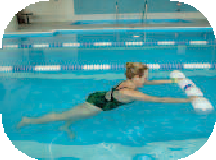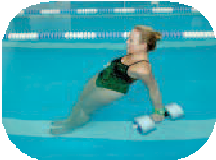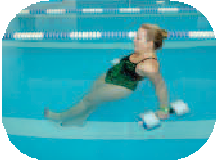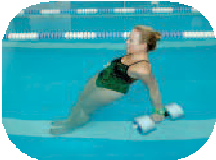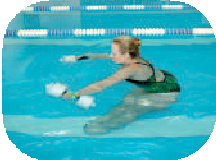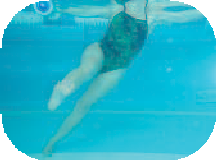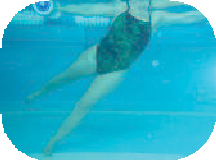Plank Challenges
Posted by Anne Pringle Burnell on Mar 2, 2012
“A good coach will make his players see what they can be rather than what they are.” – Ara Parasheghian
A warm summer’s morning. The early sun rises majestically from the lake we call Michigan. Scanning the horizon, the swimmers chug furiously doing the crawl stroke in the final leg in the triathlon. To many, this proves to be the most challenging part of that journey. The first leg, the running – familiar, upright, one leg in front of the other; we do it all the time. The second, biking – legs in a different motion; been doing it since we were kids. But that last leg, the swimming – like the mob scene of a second graders’ recess. A school of swimmers struggling for a quick breath before propelling themselves horizontally en masse toward a common goal – the Finish Line! Whether inclined horizontally or vertically, planks can be challenging.
Plank Challenges, exercises done on a diagonal line from toes to shoulders, is part of the Peyow Aqua Pilates program, based on Pilates Mat work, Reformer, Barrels and the Cadillac/Trapeze. While the program is taught as an instructor master class, it is not meant to be utilized as a workout routine. These are challenging positions and require upper body and core strength; in the instructor manual they are separated into series’ with 5 types of plank exercises.
Different Planks for Different Folks
- BASIC PLANKS – Basic planks focus on how to anchor and to activate the gluteals, to support abdominals from underneath.
- UNILATERAL PLANK – Unilateral planks focus on one limb moving and stabilizing with the opposing muscles.
- DYNAMIC PLANKS – Dynamic planks focus on dynamic stabilization in the lumbo- pelvic region.
- REVERSE PLANKS – Reverse planks focus on grounding and activating the posterior side of the body.
- SIDE PLANKS – Side planks focus on the stabilizing spinal muscles and obliques.
Plank Challenges Sampler
TURN THE CRANK (basic)
Start Position: Standing, parallel feet hip distance apart, neutral pelvis, hands in front of the body shoulder width apart on noodle or dumbbells (with dumbbells butted end-to-end to create one long dumbbell), scapula stabilizers engaged.
Inhale: Lean and float the torso forward with weight lightly supported on the dumbbells until feet rise up onto high heel position. Stop the movement from falling forward by contracting the transversus abdominis (TA) and eccentrically engaging the rectus abdominis, obliques, and latissimus dorsi.
Exhale: Continue contracting TA and flex (round) the back, lifting abdominal toward spine. Pull dumbbells downward toward pool floor, and then in toward hips, allowing hips to return to a position over the feet and heels lower to floor. Stack the spine from bottom up to return to full vertical standing position. Bend elbows to bring dumbbells or noodle to surface.
Focus: Even segmental spine motion with dynamic stabilization of core muscles.
Tip: “Engage deep abdominals to stop the floating forward”
Repeat: 20 times
Original Pilates Exercise: Up Stretch, Elephant
REVERSE STRETCH (unilateral)
Start Position: Plank position with legs together, on high heels, arms outstretched on dumbbells or noodle, hands shoulder width apart in front of body in one line.
Inhale: extend right hip and lift right leg behind body, keeping pelvis in neutral position.
Exhale: Flex left hip and move torso backwards until left foot is flat (depending on hip flexibility, ankle may go into plantar flexion) keeping right leg in arabesque.
Exhale: Lower the right leg to start posi- tion plank.
Focus: Maintain alignment and lumbar stabilization with ankle plantar flexion/dorsi-flexion. Use TA, rectus and obliques for de-acceleration of gross trunk movement.
Tip: “Parallel parking your car, go forward and back”
Repeat: Alternating legs, 10 times each.
Beginner Modification: Hold onto pool ropes with elbows bent slightly, no weights.
Original Pilates Exercise: Leg Pull Front
DOUBLE KNEE PULL ARABESQUE (dynamic)
Start position: Plank position with arms stretched out on surface of water in front of the body, elbows slightly bent, hands on noodle or dumbbells, shoulders stabilized.
Exhale: Simultaneously jump and tuck both knees up to chest, flexing elbows both arms pull the weights toward knees.
Inhale: Simultaneously shoulders flex and reach dumbbells out to start position, gluteal muscles extend hips with one leg reaching behind the body in arabesque (laterally rotated), the other landing on the floor in high heel.
Focus: Dynamic stabilization of TA muscle to de-accelerate.
Tip: “One leg up, one leg down”
Repeat: 10 times each – alternating gesture legs.
Original Pilates Exercise: Reformer Knee Stretches
REVERSE LEG PULL (reverse)
Start position: Reverse plank position. Dumbbells in hands behind the body, palms face inward. Body supine in a straight line from toes to shoulders, neck flexed slightly forward, feet plantar flexed on floor, shoulders stabilized, legs adducted.
Inhale: Lift one leg plantar flex foot.
Exhale: Dorsiflex and pull leg downward.
Focus: Maintain lumbar, pelvic, and hip stabilization while lifting leg.
Tip: “Do not sit or sag.” & “Hold hips up, feet down.”
Repeat: Perform sequence of each leg lift 3 times; on the last downward pull of the gesture leg, plantar flex to land. Switch to the other leg.
Repeat 5 times.
Original Pilates Exercise: Leg Pull
HIP BRIDGE (reverse)
Start position: Reverse plank position. Dumbbells in hands behind the body, palms face inward toward each other or toward torso. Body supine in a straight line from toes to shoulders, neck flexed slightly forward, eyes looking along surface, feet plantar flexed on floor, shoulders stabilized, legs adducted.
Inhale: Maintain feet on pool bottom and flex hips to sit back into pike position; arms reach forward and up toward surface. Keep dumbbells fully submerged.
Exhale: Activate gluteal muscles to lift hips toward ceiling into reverse plank, return arms to start position.
Focus: Gluteus activation with hip flexion and extension.
Tip: “Sit down & squeeze glutes to anchor feet on floor.”
Repeat: 10 times
Original Pilates Exercise: Advanced Mat Leg Pull
SIDE LEG KICKS (side)
Start position: Side plank legs together, arms stretched sideways, dumbbells in hands, elbows slightly bent, and palms downward. Supporting torso for scapular stabilizers, maintain static side bending of spine with obliques, and the TA limits hyperextension of trunk.
Prepare: Lift top leg
Inhale: Dorsiflex foot, kick leg in two short pulses forward maintaining alignment.
Exhale: Extend hip and kick leg to the rear, plantar flex foot. Focus: Side lying lumbar stability.
Tip: “Stack the hip bones on top of each other.”
Repeat: 10 times, repeat other side.
Modification: Dumbbells or noodle under armpits for more sup- port and to release arms from surface level.
Original Pilates Exercise: Side Lying Leg Kicks & Leg Springs Cadillac
Teaching Planks
Peyow (pronounced “pee-yow”) is the Mandarin word meaning “to float”. For many students with enough buoyancy, the “Peyow” part comes easily. However, these students need to learn how to actu- ally ground and activate the gluteals and support the abdominals from underneath. Students with less body fat and more lean body mass may need more buoyancy, like a noodle across the front or back of the chest, along with dumbbells.
• BALANCE – For front planks for beginners, have them lean against the wall with dumbbells in hands. Alternate lifting each dumbbell slightly off the wall to learn to lift and support the abdominals up into the body, and to use feet to dorsiflex and press down, while activating gluteals. Progress to pushing off the wall slightly and let them practice falling back onto the wall, the “bumper car exercise”. Progress to pushing gently off wall and hold for a second or two.
• FALL AND CATCH – Another way is to fall and catch – fall forward, then catch yourself by walking or hopping the feet up towards the fall direction or try to stop the fall.
• FORM – Shoulder stabilization is mentioned a lot in Pilates, and it should be of primary concern for us in the aquatic environment. Cervical alignment in Pilates is lengthened and following the line of the thoracic vertebrae. If the movement is flexion or rounding back forward, as in “Turn the Crank”; the neck should be long and in the same line of flexion. In forward planks, the cervical vertebrae are in slight extension, with the neck lengthened so that the natural curve is slightly extended. Cue to lengthen out of the crown of the head.
Summary
Peyow Plank Challenges can train clients to support the abdominals when reaching forward – horizontal positioning; strengthen core stabilizers; and provide a greater ability to ground – vertical positioning. Gravity keeps us horizontally, vertically, or diagonally. If there were no gravity, imagine the zigzag lines we could find ourselves in. Yet, we can prepare for the chance, out-of-the-earth’s atmosphere experience by practicing planks and find out what we can do, rather that what we thought we could. Best of all, it will help us here on our own terra firma!
Author
Anne Pringle Burnell is the creator of the Stronger Seniors® Workout Program and Peyow™ Aqua Pilates, certified by AEA, ACE, AFAA, Nia Technique Black Belt, and Stott Pilates™ and an education provider for AEA, ACE, AFAA, and Stott Pilates™. Anne teaches at The Rehabilitation Institute of Chicago, Northwestern Memorial Hospital, Peninsula Spa Chicago, University of Illinois Chicago, Elements in Motion, and Core Evolution. She has been a presenter for The American Cancer Society, The American Lung Association, Susan B. Komen Breast Cancer Foundation, National Council on Aging/American Society on Aging, Northwestern Hospital Integrative Medicine, and OSHA Center at North- western University.
Photos: Amanda Houde at the Peninsula Hotel Chicago

